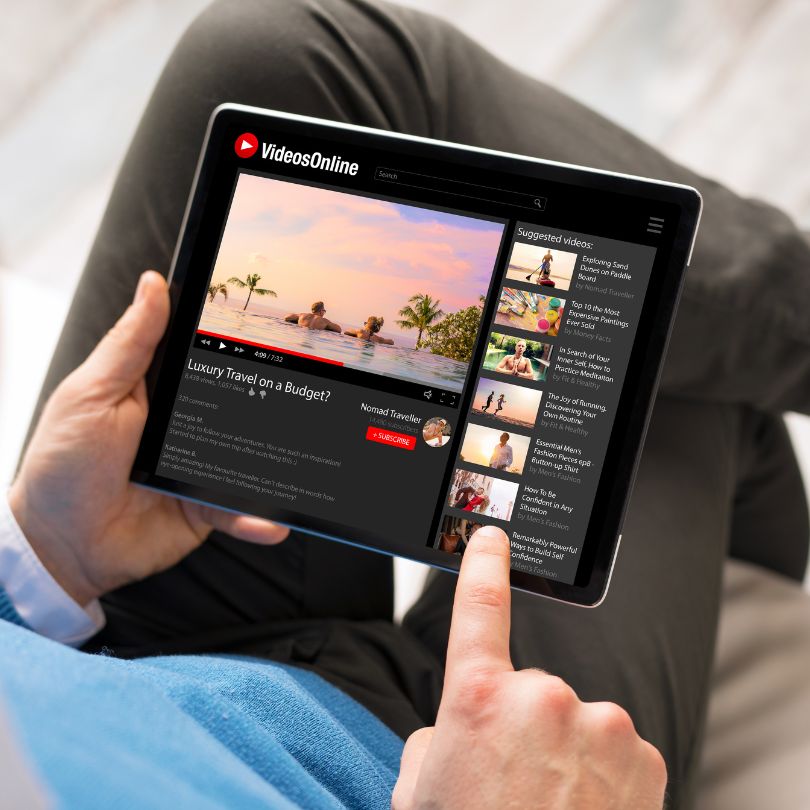
The Ultimate Guide to Video Marketing Strategies That Work
The Power of Video Marketing in 2025

Video marketing has transformed into an indispensable tool for business success in 2025. The numbers speak volumes – 96% of marketers and 91% of businesses now leverage video content to connect with their audiences and drive results.
The digital landscape demands engaging visual content, making video marketing a cornerstone of modern marketing strategies. Here’s what makes video marketing powerful in 2025:
- Higher Engagement Rates: Videos capture attention 2x faster than text content
- Improved Conversion: Businesses report 80% increase in sales when using video
- Better SEO Rankings: Websites with video content rank 50x higher in search results
- Mobile-First Experience: 75% of video consumption happens on mobile devices
- Enhanced Brand Trust: 90% of consumers say videos help them make buying decisions
Your business can leverage various video formats to achieve marketing goals:
- Product demonstrations
- Customer testimonials
- Behind-the-scenes content
- Educational how-to guides
- Live streaming events
- Animated explainer videos
The rise of AI-powered video creation tools has made it easier than ever to produce high-quality content. These tools help with:
- Automated video editing
- Personalized content generation
- Real-time analytics tracking
- Caption generation
- Smart content recommendations
By incorporating video marketing into your strategy, you position your brand to meet consumers where they are – on platforms that prioritize video content. For instance, utilizing video ads on platforms like LinkedIn can significantly grow your brand awareness and drive qualified leads to your business.
Additionally, understanding risk assessment techniques can further enhance your affiliate marketing strategies by identifying potential pitfalls and optimizing your approach for better results.
1. Understand Your Target Audience
Creating effective video content starts with knowing exactly who you’re talking to. Your buyer personas serve as detailed representations of your ideal customers, including:
- Age range and generational preferences
- Professional background and income levels
- Content consumption habits
- Daily challenges and aspirations
- Preferred social media platforms
- Purchase decision factors
Research and data analysis reveal crucial insights about your audience’s behavior patterns. Tools like Google Analytics, social media insights, and customer surveys help you uncover:
- Peak viewing times for your target demographic
- Average watch duration preferences
- Device usage patterns
- Content format preferences
- Common pain points and questions
Your video content needs to reflect these audience insights. A B2B software company might create detailed product tutorials, while a fashion brand could focus on quick, trendy styling tips. The key lies in matching your video style, length, and messaging to your audience’s specific needs and preferences.
2. Set Clear Objectives and Measurable Goals
Setting specific, measurable goals for your video marketing campaigns creates a clear path to success. Your objectives shape every aspect of your video content strategy:
- Brand Awareness Goals: Video view counts, social media shares, subscriber growth, geographic reach
- Engagement Goals: Watch time duration, comments and interactions, click-through rates, social media reactions
- Conversion Goals: Lead generation numbers, email sign-ups, product purchases, demo requests
Track these key performance indicators (KPIs) through analytics platforms like Google Analytics, YouTube Studio, or social media insights. Set realistic benchmarks based on your industry standards and past performance data. A structured approach to measuring success helps you identify which video types resonate with your audience and deliver the best return on investment.
Remember to establish timeframes for achieving your goals – whether it’s monthly view targets or quarterly conversion rates. This timeline creates accountability and helps you adjust your strategy based on real-time performance data.
3. Create Compelling and Engaging Video Content
Creating videos that captivate your audience requires mastering the art of storytelling and viewer engagement. Here’s how to craft content that keeps your viewers watching:
Hook Your Viewers in the First 8 Seconds
- Start with a provocative question
- Share a surprising statistic
- Present a relatable problem
- Use eye-catching visuals
- Create intrigue with a teaser
Apply These Storytelling Elements
- Protagonist: Feature a character your audience identifies with
- Conflict: Present a challenge or pain point
- Journey: Show the path to resolution
- Resolution: Demonstrate how your product/service solves the problem
Best Practices for Engagement
- Keep videos concise – under 2 minutes for social media
- Include captions for accessibility
- Use dynamic camera angles
- Incorporate music that matches your message
- Break complex ideas into digestible segments
Video Structure Tips
- Start strong with your main message
- Build tension through the middle
- End with a clear takeaway
- Include branded elements consistently
- Maintain steady pacing throughout
Your video content should follow a natural progression that guides viewers through your message. Each scene builds upon the previous one, creating a cohesive narrative that maintains interest from start to finish. Remember to test different storytelling approaches with your audience to discover what resonates best with them.
4. Optimize Your Videos for Search Engines and Different Platforms
SEO optimization is crucial for increasing the visibility of your videos on search engine results pages (SERPs). To achieve this, implement the following strategies:
- Titles: Craft compelling and keyword-rich titles that accurately reflect the content of your video. Ensure they are concise yet descriptive to attract viewers and improve click-through rates.
- Descriptions: Write detailed descriptions that incorporate relevant keywords naturally. Include essential information about the video, along with links to your website or related resources.
- Tags: Use specific and relevant tags to help search engines understand the context of your video. This improves discoverability by categorizing your content appropriately.
Adapting your videos for different social media platforms involves customizing content based on platform-specific requirements and audience preferences:
- YouTube: Focus on longer-form content with engaging thumbnails, detailed descriptions, and relevant tags. Utilize YouTube’s playlist feature to organize related videos and keep viewers engaged.
- Instagram: Create short, visually appealing videos optimized for vertical viewing. Use Instagram Stories for ephemeral content and IGTV for longer, more in-depth videos.
- TikTok: Leverage TikTok’s format by producing quick, engaging clips that align with trending topics or challenges. Incorporate popular music tracks and hashtags to increase reach.
- LinkedIn: Share professional content such as industry insights, company updates, or educational tutorials. Aim for a more polished and informative approach tailored to a business-oriented audience.
By optimizing your videos for SEO and customizing them for different platforms, you maximize their reach and engagement potential across diverse audiences.
5. Distribute and Promote Your Videos Effectively
Strategic video distribution amplifies your reach and maximizes engagement across multiple platforms. Each distribution channel serves a unique purpose in your video marketing strategy:
Primary Distribution Channels:
- YouTube – Perfect for long-form content and SEO benefits
- Instagram – Ideal for short, visually appealing content
- LinkedIn – Professional content and B2B marketing
- TikTok – Trending, creative content for younger audiences
- Website/Blog – Owned media platform for complete control
Engagement Tactics That Drive Results:
- Create platform-specific hashtag strategies
- Schedule posts during peak audience activity times
- Cross-promote videos across different channels
- Embed videos in relevant blog posts and landing pages
- Share video snippets to tease longer content
Interactive Elements to Boost Participation:
- Run video-based contests with user-generated content
- Create polls in Instagram Stories or YouTube Community tabs
- Ask questions in video descriptions to spark discussions
- Include clickable elements within your videos
- Design challenges that encourage viewer responses
Your video promotion strategy should align with your audience’s platform preferences. Track engagement metrics on each channel to identify where your content performs best and adjust your distribution approach accordingly. Experiment with different posting times and promotional tactics to discover what resonates with your target viewers.
6. Measure and Analyze the Performance of Your Video Campaigns
Success in video marketing requires a data-driven approach to measuring performance. Here are the essential metrics you need to track:
Key Performance Indicators (KPIs)
- Watch time
- View count
- Engagement rate
- Click-through rates
- Social shares
- Conversion rates
- Audience retention
- Comments and interactions
The data from these metrics tells you what content resonates with your audience. A high watch time but low engagement might indicate interesting content that lacks a clear call-to-action. Low view counts with high conversion rates suggest highly targeted content reaching the right audience.
Making Data-Driven Improvements
Your analytics reveal patterns to optimize future campaigns:
- Study drop-off points in videos to identify where viewers lose interest
- Compare performance across different video lengths
- Test various posting times to maximize reach
- Analyze platform-specific metrics to tailor content
- Track audience demographics to refine targeting
For instance, Anstrex, a tool that allows you to spy on top TikTok ad campaigns, could provide valuable insights into successful strategies that you can replicate for your video marketing efforts.
Create a monthly performance review cycle to implement these insights. A/B test different elements like thumbnails, titles, and video lengths. Use heat maps to understand which parts of your videos generate the most engagement.
Remember: Numbers tell stories. When your engagement drops, investigate why. When certain videos outperform others, replicate those successful elements in future content. Let data guide your creative decisions while maintaining authenticity in your messaging.